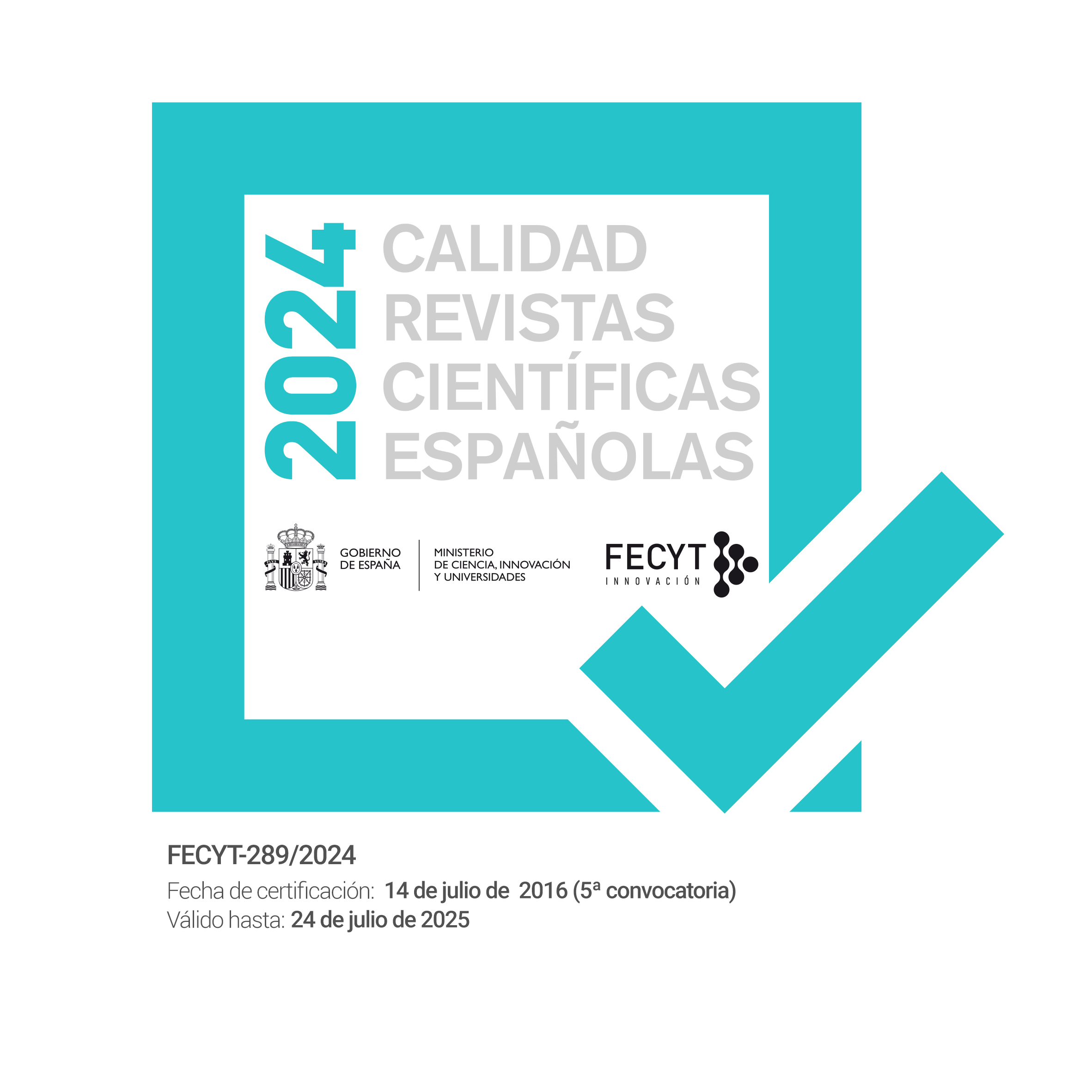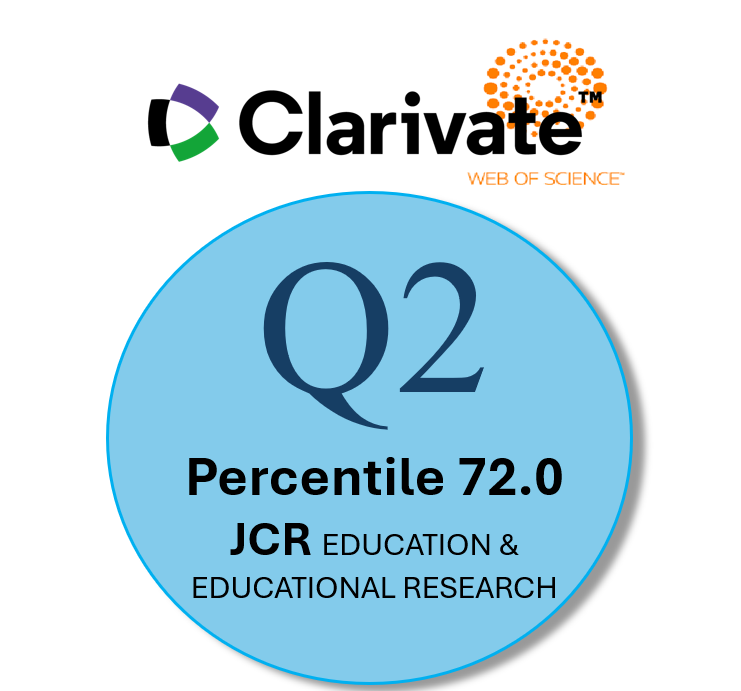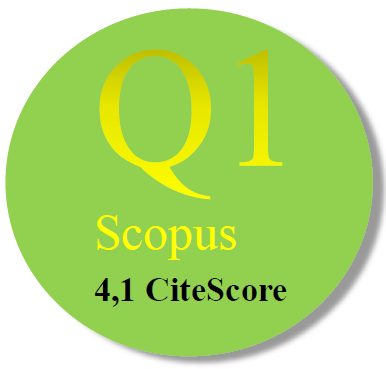An intervention of spatial sense with Tinkercad in future teachers
Abstract
A five-session classroom intervention is presented for the teaching and application of Tinkercad 3D design software with second-year students of the Primary Education Degree. These students do not know the tool or any similar one, and they have not worked on Geometry content since their compulsory education. To find out the impact of this proposal, a pre-test and a post-test are carried out on the participants through the Spatial Aptitude tests of the EFAI and BAT7 Intelligence Tests, as well as an initial survey to find out their satisfaction with the intervention and proposals for improvement. The results in spatial aptitude have improved, reducing the percentage of students with low enneatype and increasing that of high enneatype, slightly decreasing that of medium enneatype, and 22.5 % of the participants remain in the same enneatype, 60 % go up and 17.5 % drop. Satisfaction and improvement surveys suggest new ways of working for the future and reaffirm the interest and possibilities of using this resource.
Downloads
-
Abstract1726
-
PDF (Español (España))1280
References
Bauzá, T. (2021). EVEA guiat de disseny de material 3D amb platarforma digital col laborativa. [Treail de Fi de Grau, Universitat de les Illes Balears]. https://dspace.uib.es/xmlui/handle/11201/155823?show=full
Beltrán-Pellicer, P. y Muñoz-Escolano, J. M. (2021). Una experiencia formativa con BlocksCAD con futuros docentes de matemáticas en secundaria. Didacticae, 10, 71-90. https://dialnet.unirioja.es/servlet/articulo?codigo=8217770
Beltrán-Pellicer, P. y Rodríguez, C. (2017). Modelado e impresión en 3D en la enseñanza de las matemáticas: un estudio exploratorio. ReiDoCrea, 6, 16-28. https://dialnet.unirioja.es/servlet/articulo?codigo=5908617
Cattell, R. B. (1971). Abilities: Their structure, growth and action. Houghton-Mifflin.
Codina, A., García, M. M., Romero, I. M. y Lupiañez, J. (2022). Poliedros con el software de realidad virtual inmersiva Neotrie VR, una experiencia con maestros en formación. Revista Electrónica Interunivesitaria de Formación del Profesorado, 25(3), 1-14. https://doi.org/10.6018/reifop.531841
Cruz, A. y Ramírez, R. (2018). Componentes del sentido espacial en un test de capacidad espacial. En L. J. Rodríguez-Muñiz, A. Aguilar-González, P. Alonso, F. J. García García y A. Bruno (Eds.), Investigación en Educación Matemática XXII (pp. 211-220). SEIEM. https://www.seiem.es/docs/actas/22/ActasXXIIDefinitivas.pdf
Del Cerro, F. y Morales, G. (2017). Realidad Aumentada como herramienta de mejora de la inteligencia espacial en estudiantes de educación secundaria. RED. Revista de Educación a Distancia. Núm. 54. Artic. 5. http://dx.doi.org/10.6018/red/54/5
Del Cerro Velázquez, F. & Morales Méndez, G. (2021a). Application in Augmented Reality for Learning Mathematical Functions: A Study for the Development of Spatial Intelligence in Secondary Education Students. Mathematics, 9(4), 369. https://doi.org/10.3390/math9040369
Del Cerro Velázquez, F. & Morales Méndez, G. (2021b). Systematic Review of the Development of Spatial Intelligence through Augmented Reality in STEM Knowledge Areas. Mathematics, 9(23), 3067. https://doi.org/10.3390/math9233067
Detterman, D. K. (1982). Does “g” exist? Intelligence, 6(2), 99-108. https://doi.org/10.1016/0160-2896(82)90008-3
Eryilmaz, G. C. & Deniz, G. Effect of Tinkercad on Students´Computational Thinking Skills and Perceptions: A Case of Ankara Province. TOJET: The Turkish Online Journal of Educational Technology, 20(1), 25-38. https://files.eric.ed.gov/fulltext/EJ1290797.pdf
Fernández-Blanco, T. (2013). La investigación en visualización y razonamiento espacial. Pasado, presente y futuro. En A. Berciano, G. Gutiérrez, A. Estepa y N. Climent (Eds.), Investigación en Educación Matemática XVII (pp. 19-42). SEIEM. https://www.seiem.es/docs/actas/17/Actas17SEIEM.pdf
Fernández-Blanco, T. y Fernández-López, A. (2021). Pilgrimage way to Santiago de Compostela through robotics and 3d Printing in primary classroom. In DULEARN21 Proceedings (pp. 11628-11633). IATED. https://dialnet.uniroja.es/servlet/articulo?codigo=8608465
Fernández-Blanco, T., Godino, J. D. y Diego-Mantecón, J. M. (2018) Análisis Epistémico y Cognitivo de una Terea de Visualización en el Espacio Bidimensional. Redimat, 7(3), 251-279. https://dialnet.uniroja.es/servlet/articulo?codigo=8608465
Ferrándiz, C., Prieto, M. D., Bermejo. M. R. y Ferrando, M. (2006). Fundamentos psicopedagógicos de las inteligencias múltiples. Revista Española de Pedagogía, 233, 5-20. https://dialnet.uniroja.es/servlet/articulo?codigo=1973251
Feuerstein, R. (1980). Instrumental Enrichment Program. Glenview, II: Scott, Foresman and Co.
Flores, P., Ramírez, R. y del Rio, A. (2015). Sentido espacial. En P. Flores y L. Rico (Coord.), Enseñanza y aprendizaje de las matemáticas en educación primaria (pp. 127-146). Pirámide.
Gardner, H. (1983). Frames of mind. Basic Books. Traducción al castellano, Estructuras de la mente. La teoría de las Inteligencias Múltiples. Fondo de Cultura Económica, 1987.
González, B. (2020). Estudio de la Geometría tridimensional mediante software de modelado 3D. [Tesis Fin de Máster, Universidad de La Laguna]. http://riull.ull.es/xmlui/handle/915/22976
Gonzato, M. (2013). Evaluación de conocimientos de futuros profesores de educación primaria para la enseñanza de la visualización espacial. [Tesis doctoral, Universidad de Granada]. http://hdl.handle.net/10481/20318
Hebb, D. O. (1949) La organización del comportamiento. Wiley & Sons.
Hunt, E. (1973). The memory we must have. En R. Schanck y K. Colby (comp.), Computer simulation of information processes is man. Freeman.
Ley Orgánica 3/2020 de diciembre, por la que se modifica la Ley Orgánica 2/2006, de 3 de mayo, de Educación. BOE, 340, de 30 de diciembre de 2020, 122868-122953. https://www.boe.es/boe/dias/2020/12/30/pdfs/BOE-A-2020-17264.pdf
Mateos Núñez, M. (2021). Diseño y validación de metodologías didácticas aplicadas en el aula de Educación Primaria para mejorar el dominio cognitivo y emocional en la enseñanza/aprendizaje de competencias STEM. [Tesis de doctorado, Universidad de Extremadura]. https://dialnet.uniroja.es/servlet/tesis?codigo=302259
Mayor, J. (1985). Actividad humana y procesos cognitivos. Alhambra Universidad.
Monge, C. A. (2021). Análisis de las dimensiones del sentido espacial en futuros profesores. [Trabajo Fin de Máster. Universidad de Granada]. https://10.30827/Digibug.71036
Montes de Oca, A. (2021). Adquisición de la visión espacial mediante el uso de diferentes materiales, recursos y herramientas informáticas. Iniciación a la impresión 3D a través de Tinkercad. [Trabajo Fin de Máster. Universidad de La Laguna]. http://riull.ull.es/xmlui/handle/915/22756
Moreno, A. M. (2016). Impresión 3D para la enseñanza de la Geometría en 5.º de Primaria. [Trabajo Fin de Grado, Universidad de La Rioja]. https://reunir.unir.net/bitstream/handle/123456789/3578/MORENO%20GARCIA%2C%20ANA%20MARIA.pdf?sequence=1
NCTM (2003). Principios y estándares para la educación matemática. Sociedad Andaluza de Educación Matemática Thales.
Nortes, R. y Nortes, A. (2022). La competencia matemática de futuros maestros antes y después del confinamiento por la Covid-19. RED. Revista de Educación a Distancia. Núm. 70, Vol. 22. Artíc. 3. http://dx.doi.org/10.6018/red.513541
Pinillos, J. (1981). La mejoría científica de la inteligencia. Análisis y modificación de conducta, 7(14 y 15), 115-154.
Quiroz, J. L. y Elizarraras, S. (2021). Retos de futuros docentes de Matemáticas al aprender Robótica Educativa en pandemia. Revista Unión, 63, 1-11. http://funes.uniandes.edu.co/29811/1/Medardo2021Retos.pdf
RAE (2022). Diccionario de la lengua española. https://dle.rae.es/
Real Decreto 157/2022, de 1 de marzo, por el que se establecen la ordenación y las enseñanzas mínimas de la Educación Primaria. BOE, 52, de 2 de marzo de 2022, 24386-24504. https://www.boe.es/boe/dias/2022/03/02/pdfs/BOE-A-2022-3296.pdf
Roura, R. y Ramírez, R. (2021). Sentido espacial en futuros maestros. En Diago, P. D., Yáñez, D. F., González-Astudillo, M. T. y Carrillo, D. (Eds.), Investigación en Educación Matemática XXIV (pp. 537-544). SEIEM. https://www.seiem.es/docs/actas/24/ActasXXIVSEIEM.pdf
Ruíz-Hidalgo, J. F. y Flores, P. (2022). Sentido matemático escolar. En L. Blanco, N. Climent, M. T. González, A. Moreno, G. Sánchez-Matamoros, C. de Castro y C. Jiménez (Eds.), Aportaciones al desarrollo del currículo desde la investigación en educación matemática (pp. 55-79). EUG-SEIEM. https://editorial.ugr.es/libro/aportaciones-al-desarrollo-del-curriculo-desde-la-investigacion-en-educacion-matematica_139289/
Stemberg, R. J. (1984). Beyond IQ: A Triarchic Theory of Intelligence. Cambridge University Press.
Stemberg R. J. y Detterman, D. K. (1982). ¿Qué es la inteligencia? Enfoque actual de la naturaleza y su definición. Pirámide.
Thurstone, L. L. y Thurstone, Th. G. (1976). Aptitudes Mentales Primarias (PMA). Tea ediciones.
Vega-Moreno, D., Cufié, X., Rueda, M. J. & Llinás, D. (2016). Integración de robótica educativa de bajo coste en el ámbito de la educación secundaria para fomentar el aprendizaje por proyectos. International Journal of Educational Research and Innovation (IJERI), 6, 162-175. https://upo.es/revistas/index.php/IJERI/article/view/1653
Vernon, P.E. (1969). Differences genetiques et culturelles dans les aptitudes: implications scolaires et professionelles, Sumposium, XVII Congreso Internacional de Psicología Aplicada, Liege, 1971. Actas Edite at Brixelles, 1972.
Vygotsky, L. (1934). Pensamiento y lenguaje. Ediciones Fausto.
Whimbey, A. y Shaw, L. (1976). La inteligencia puede enseñarse. Bantam.
Yela, M. (1983). La inteligencia, la percepción y otros estudios psicológicos. Anthropos, 23, 26-29.
Zichar, M. (2022). Mathability in the Fields of 3D Printing and Modeling. Acta Polytechnika Hungarikca, 19(1), 31-49. https://10.12700/APH.19.1.2022.19.3
Copyright (c) 2023 Distance Education Journal

This work is licensed under a Creative Commons Attribution-NonCommercial 4.0 International License.
Las obras que se publican en esta revista están sujetas a los siguientes términos:
1. El Servicio de Publicaciones de la Universidad de Murcia (la editorial) conserva los derechos patrimoniales (copyright) de las obras publicadas, y favorece y permite la reutilización de las mismas bajo la licencia de uso indicada en el punto 2.
2. Las obras se publican en la edición electrónica de la revista bajo una licencia Creative Commons Reconocimiento-NoComercial-SinObraDerivada 3.0 España (texto legal). Se pueden copiar, usar, difundir, transmitir y exponer públicamente, siempre que: i) se cite la autoría y la fuente original de su publicación (revista, editorial y URL de la obra); ii) no se usen para fines comerciales; iii) se mencione la existencia y especificaciones de esta licencia de uso.
3. Condiciones de auto-archivo. Se permite y se anima a los autores a difundir electrónicamente las versiones pre-print (versión antes de ser evaluada) y/o post-print (versión evaluada y aceptada para su publicación) de sus obras antes de su publicación, ya que favorece su circulación y difusión más temprana y con ello un posible aumento en su citación y alcance entre la comunidad académica. Color RoMEO: verde.













